Bats
In 2020, Jean-Pierre Bacle discovered a Silver-haired Bat (Lasionycteris noctivagans) at Monticello Park. He monitored the bat and wrote a report about it (see below). In 2021 and 2022, he recorded the vocalizations of bat species at Monticello Park. This is an example of a citizen science project that can be done by an individual.
Summary
At sunrise on May 10, 2020 a bat was observed gleaning above the surface waters of the upper reaches of the stream in Monticello Nature Park (MNP). Shortly after the bat headed for its daily roost at a nearby tree. After visual analysis and photographic evidence, the specimen was confirmed to be a Silver-haired Bat, (Lasionycteris noctivagans)1, the first official record for the park.
Location
Monticello Nature Park is a 2.52 hectares (6.24 acres) woodland in a residential neighborhood of Alexandria. The area is a riparian tributary densely covered with tall canopy trees and secondary growth. The park is dissected in roughly two halves by a stream where drainage is controlled by a series of weirs. An array of trails provides access along both sides of the stream and adjacent valley slopes. The park has multipurpose use and attractions including being a hot spot for migratory birds. Detailed information on Monticello Nature Park is available at www.mpnature.com.
Observations
A bat species was first observed gleaning over surface water between the second and third weirs downstream of the southern culvert. The three weirs established for flood control allow ponding which attracts wildlife use.
Shortly after foraging the pond, the bat landed on a nearby elm tree (Ulmus rubra) likely its daily roosting site (Photo 1). GPS site coordinates are 38°49'56.4" N - 77°04'13.9" W. Preliminary observations identified the specimen as a Silver-haired Bat2 (Photos 2-3). Photographic evidence sent to Dr. Kwiecinski (Chiropteran specialist) at the University of Scranton confirmed the species (Kwiecinski, 2020).
The Silver-haired Bat is a medium-sized bat found throughout the state of Virginia. Weight ranges between 8-12 gm; total length between 92-115 mm; and a wingspan of about 270-320 mm (Bentley, 2017). Its pelage varies from dark brown to black with distinguishable silver-tipped fur (Harvey et al., 2011). This latter characteristic enabled its identification from other similar species in the Vespertilionidae family.
The Silver-haired Bat is insectivore and feeds mainly on moths and a variety of soft body insects. Preferred foraging and roosting habitats are in proximity of streams and woodland ponds. The species is primarily solitary, roosting solo during summer days in tree cavities and under loose bark. As with all bat species they are nocturnal with peak feeding in early evening and pre-dawn.
Since first observed on May 10th, the Silver-haired Bat was recorded at the same roost for over 3 weeks till daily observations discontinued. It is likely that the species will occupy the same roost till early fall whence breeding season and subsequent migration begins.
Little is known about the Chiropteran fauna in the park. The Silver-haired Bat is the first documented as roosting in MNP. There is a strong likelihood that many more species roost and forage in the park. A Big Brown Bat (Eptesicus fuscus) was recorded once by William Young and Harry Gurkin a few years back (Young, 2020). According to Young, they observed an injured specimen crawling on the ground beyond the picnic area (Photo 4), and later that day noted the specimen was no longer at that location. The bat likely headed into the foliage for safety and to recover, and since most bats are unable to take flight from ground level it is also possible the specimen climbed up a tree and waited for nighttime before taking flight.
To attract bat roosting in the park, a bat house was installed circa 2010 by former City of Alexandria naturalist Mark Kelley (Simmons, 2020). No roosting data was recorded after installation, mainly due to lack of resources such as trained volunteers. Throughout the years the bat house has suffered significant damage apparently from woodpeckers (Photo 5). With minimum effort the bat structure could be restored, and a volunteer monitoring program be initiated.
A novel approach could be the use of a bat detector to monitor bat activity. One such bat detector is the Echo Meter Touch 2 that runs on iOS or Android (Photo 6). The author acquired such a device last summer from Wildlife Acoustics, and it was used multiple times locally and in other States such as New Mexico and Utah. This sophisticated plug-in device (Echo Meter Touch 2) lets you hear and record bats as they fly by, and automatically identifies the most likely species. This device could yield important data on the number of species that frequent MNP as a foraging opportunity area and on species activity levels throughout the year.
Habitat Preservation
Stressed by its residential surroundings, MNP has become an island refuge and hotspot for a variety of wildlife and native plants species. However, throughout the years an increase of multiuse activity has occurred within the park. Particularly so during this Covid-19 pandemic year where school and work-related closures made MNP an attractive gathering ground for leisure activities.
Landscape deterioration in the form of trail erosion, hillside erosion, and trampling of ground vegetation is evident throughout. To ensure the future legacy and preservation of the park's habitat and wildlife, these environmental issues will have to be addressed soon and in a practical manner.
References
Bentley, J. 2017. Lasionycteris noctivagans at Animal Diversity.
Harvey, M.J., J.S. Altenbach and T.L. Best. 2011. Bats of the United States and Canada. JHU Press.
Kwiecinski, G., 2020. Pers. comm., email (5/12/2020).
Simmons, R., 2020. Pers. comm., email (9/23/2020).
Young, W., 2020. Pers. comm., email (6/30/2020).
Notes
1. The scientific name Lasionycteris noctivagans is derived from Greek and Latin words meaning "night wandering shaggy bat".
2. Only visual observations and photos were taken. Extra care was taken to not disturb the bat. Capturing or handling bats would require wildlife permits. In addition, since the Covid-19 outbreak, U.S. Fish and Wildlife Service (FWS) and the Canadian Wildlife Health Co-Operative (CWHC) have put a temporary ban on fieldwork and handling bats in both countries.
Photos
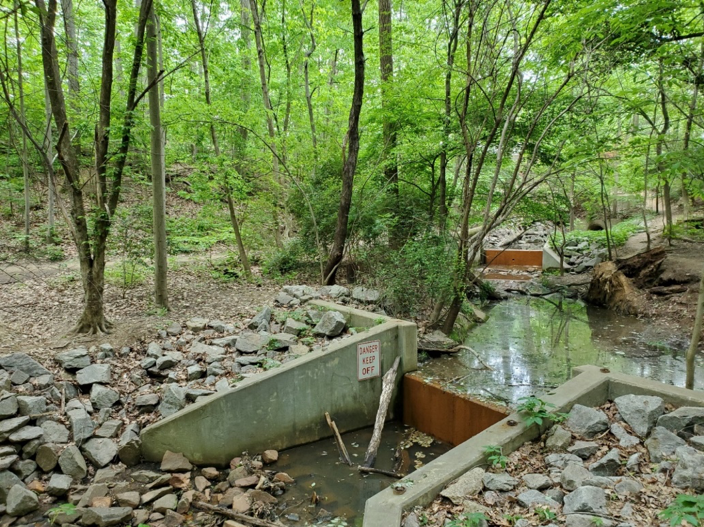
Photo by Jean-Pierre Bacle
A view of the roost site with the weirs in the foreground. The bat was gleaning the surface waters. Its roost was at the base of the lowest vee in the elm tree to the far left.
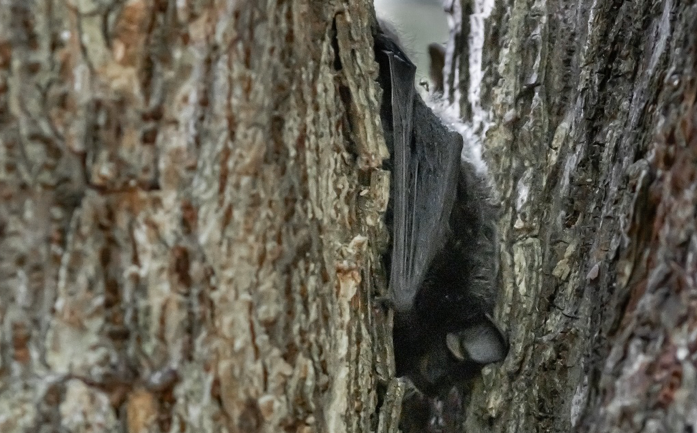
Photo by Todd Kiraly
Silver-haired Bat wedged between main branches of the elm tree.
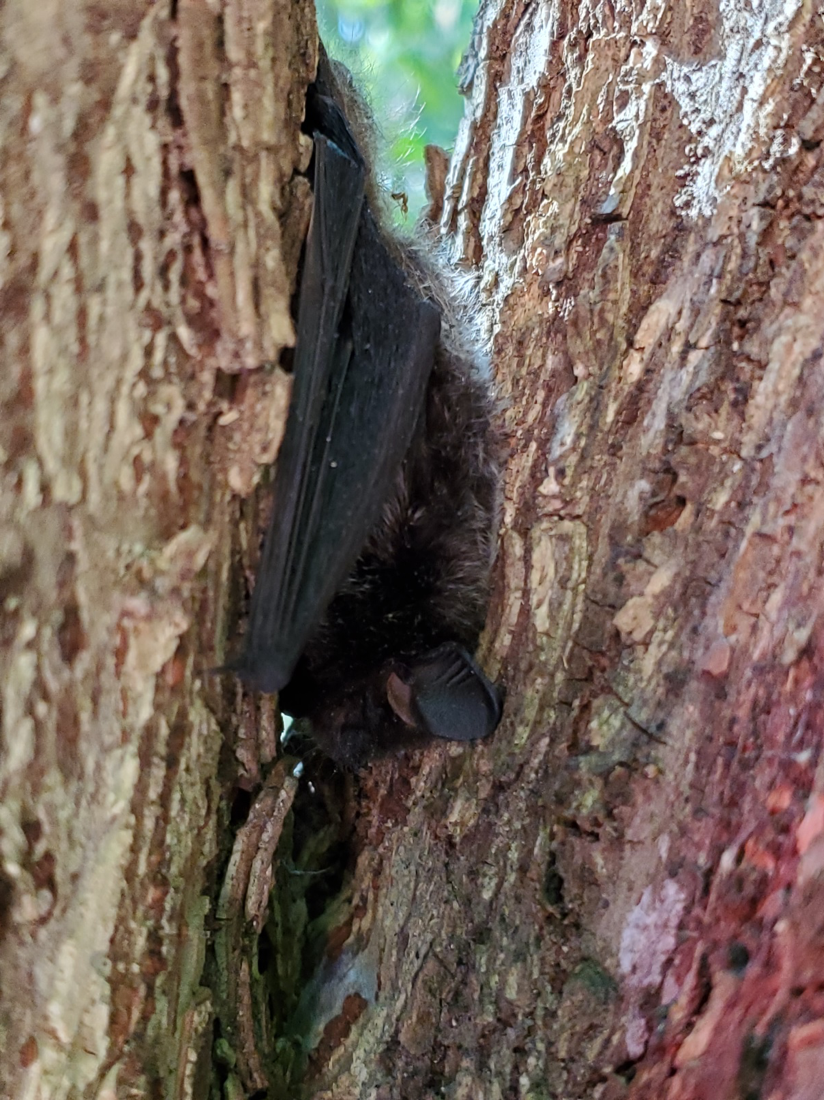
Photo by Jean-Pierre Bacle
Closeup of the Silver-haired Bat roosting upside down in the wedge of the elm tree. Notice silver tip fur extending throughout dorsal and tail membrane (uropatagium).
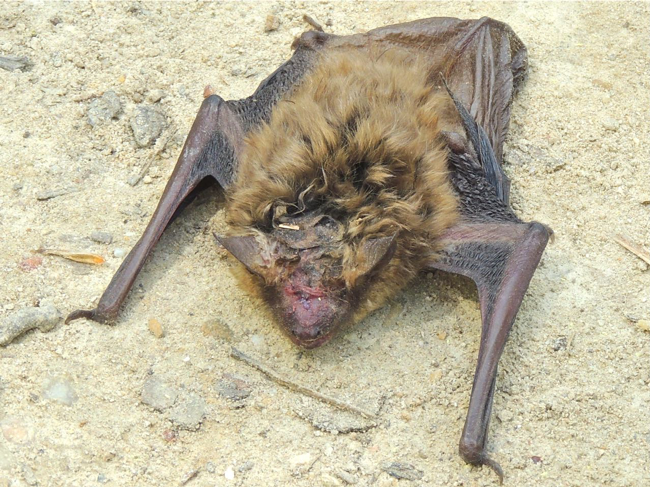
Photo by William Young
Big brown bat crawling on the ground with noticeable head injury.
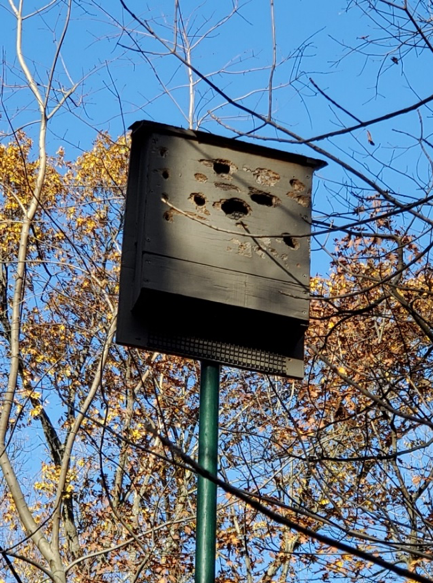
Photo by Jean-Pierre Bacle
Bat house (damaged by woodpeckers) on the west side of the stream.
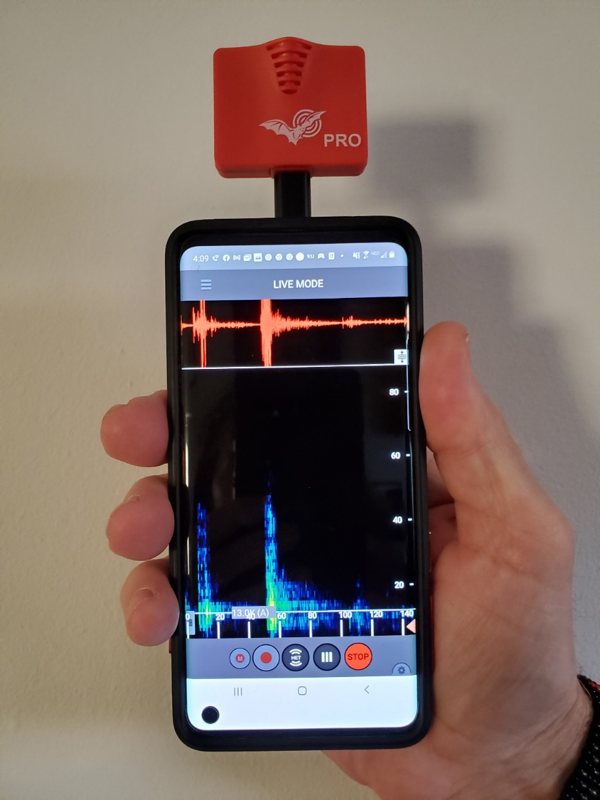
Photo by Michele Lemay
The Echo Meter Touch 2 bat detector that runs on iOS or Android. It consists of an ultrasonic module (in red) and a free downloadable app.
